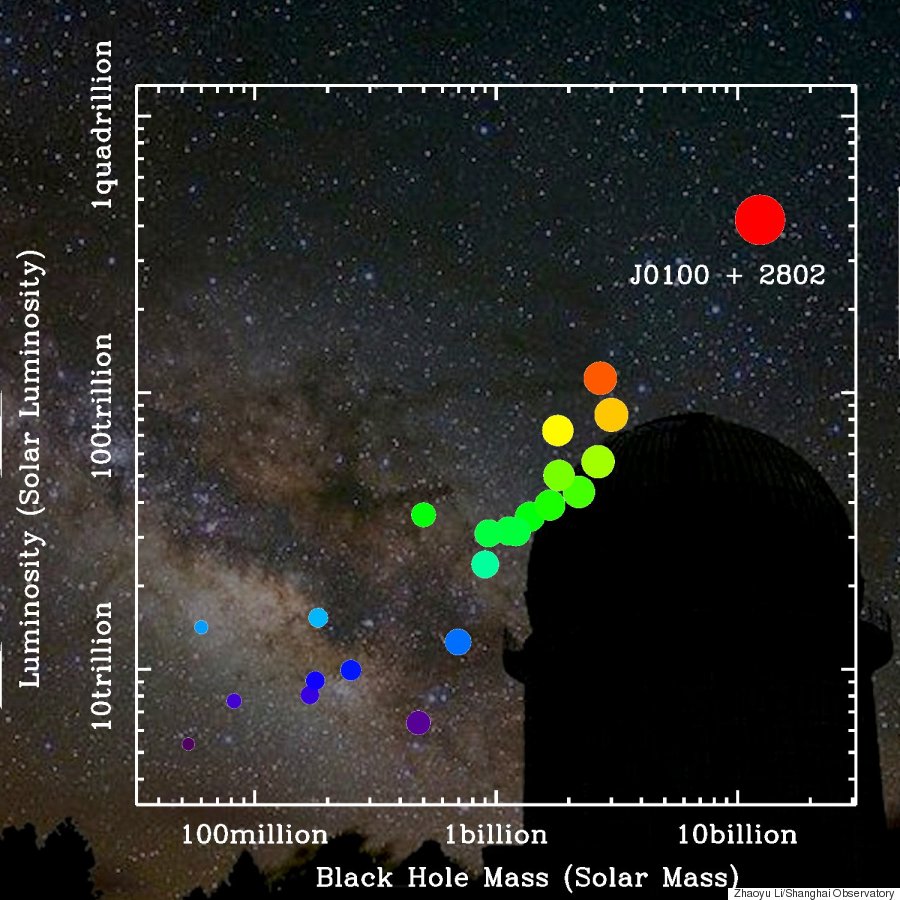I well remember a meeting of the Bristol Astronomical Society in the 1970s when Heather Couper stood in for Patrick Moore (his mother was taken ill). When Couper mentioned astronomers believed there was a black hole at the centre of our galaxy I remember two journalists near me panicked. Looking at me they asked: "How long have we got??"
I tried to explain how big our galaxy was and all the usual stuff but these were journalists: "Is that near Mars or--" At which point I noted they had confused "galaxy" with "Solar system".
"What's the difference?
meh.
I only mention this as whoever wrote the headline...well, internet news writer.
VERY interesting news item though....
***********************************************************************
A black hole 12
billion times as massive as the sun has been found in a glowing quasar
that existed when the universe was just a fraction of its current age,
scientists said.
Found within the distant
celestial bodies called quasars, black holes are regions of space so
dense with matter that not even light can travel fast enough to escape
their gravitational pits. Black holes are detected by effects they have
on nearby galaxies, stars and dust.
By comparison, the black hole lurking at the centre of the Milky Way galaxy has about 4 million to 5 million times the mass of the sun.
Scientists cannot explain how the newly found black hole grew so quickly. Theoretically, it could not have fed off surrounding gas as fast and as long as it would have needed to reach its massive size under currently understood laws of physics.
“Our discovery presents a serious challenge to theories about the black hole growth in the early universe," lead researcher Xue-Bing Wu with Peking University in Beijing, wrote in an email.
"It may require either very
special ways to grow the black hole within a very short time or the
existence of a huge seed black hole when the first generation stars and
galaxies formed. Both are difficult to be explained by the current
theories.”
Clues may come from the quasar itself, which is glowing brightly enough to illuminate interstellar matter between itself and telescopes on and orbiting Earth. Ancient quasars may provide information about how stars formed in the early universe.
The research is published in this week’s issue of the journal Nature.
________________________________________________________________________
I much prefer the more understated Huff Post version....
Black holes should take billions of years to get that big, according to current theories, and there are theoretical limits on how fast they can grow. So the existence of the newfound monster is raising serious questions about how black holes evolve.
"The discovery of this record-breaking monster black hole ... raises an embarrassing unanswered question: how did it form?" Dr. Max Tegmark, a MIT cosmologist who was not involved in the discovery, told The Huffington Post in an email. "If it started out as a collapsing star, then this black hole ate about a billion times its birth weight to get this heavy: how did it manage to eat so much in so little time?"

Artist's impression of a quasar with a supermassive black hole in the distant universe.
The black hole lies at the center of a bright cloud of material, a celestial object known as a quasar, called SDSS J0100+2802. This object is located 12.8 billion light-years from Earth and is 420 trillion times brighter than the sun.
The quasar was spotted by a team of researchers using the Lijiang Telescope in Yunnan, China -- and the mass and distance of the black hole were confirmed by observations made with telescopes in Arizona, Hawaii, and Chile. Though black holes can't be seen directly, astronomers can infer their existence and size based on observations of the matter falling into them.
The researchers hope that further observations of the quasar, using the Hubble Space Telescope and Chandra X-Ray Telescope, will shed new light on the formation of black holes and galaxies in the early universe.
"This quasar is very unique," co-researcher Dr. Xue-Bing Wu, an astronomy professor at Peking University and the associate director of the Kavli Institute of Astronomy and Astrophysics, said in the statement. "Just like the brightest lighthouse in the distant universe, its glowing light will help us to probe more about the early universe."

The newly discovered quasar, SDSS J0100+2802, is the one with the most massive black hole and the highest luminosity among all known distant quasars. The background photo, provided by Yunnan Observatory, shows the dome of the 2.4-meter telescope and the sky above it.
The research was published online Feb. 25 in the journal Nature.
_____________________________________________________________________________
The questions arising from this discovery are really HUGE and just go to prove that science never claims -as a "body"- that it knows all the answers. It still makes discoveries that throw out the accepted text books in a major way.
A black hole 12 nillion times larger than our sun based on calculations and inference -no actual solid "we've seen it. We've touched it. It's real!"
But good observers including naturalists observe an unknown sea creature swimming about and it's: "You inferred it was that size. You inferred it was unknown -where is your proof?"
Science and it's hipocrisy can be as irritating as an infected hemorrhoid.

No comments:
Post a Comment